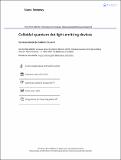Colloidal quantum dot light-emitting devices
Author(s)
Wood, Vanessa; Bulović, Vladimir
DownloadPublished version (2.689Mb)
Terms of use
Metadata
Show full item recordAbstract
Colloidal quantum dot light-emitting devices (QD-LEDs) have generated considerable interest for applications such as thin film displays with improved color saturation and white lighting with a high color rendering index (CRI). We review the key advantages of using quantum dots (QDs) in display and lighting applications, including their color purity, solution processability, and stability. After highlighting the main developments in QD-LED technology in the past 15 years, we describe the three mechanisms for exciting QDs - optical excitation, Förster energy transfer, and direct charge injection - that have been leveraged to create QD-LEDs. We outline the challenges facing QD-LED development, such as QD charging and QD luminescence quenching in QD thin films. We describe how optical downconversion schemes have enabled researchers to overcome these challenges and develop commercial lighting products that incorporate QDs to achieve desirable color temperature and a high CRI while maintaining efficiencies comparable to inorganic white LEDs (>65 lumens per Watt). We conclude by discussing some current directions in QD research that focus on achieving higher efficiency and air-stable QD-LEDs using electrical excitation of the luminescent QDs.
Date issued
2010Department
Massachusetts Institute of Technology. Department of Electrical Engineering and Computer ScienceJournal
Nano Reviews
Publisher
Informa UK Limited